#Peer-Reviewed Computer Science Journal
Explore tagged Tumblr posts
Text

The Indian Journal of Computer Science and Technology (INDJCST) is a peer-reviewed academic journal that delivers cutting-edge research and advancements in computer science to scientists, engineers, and technology professionals.
It highlights the latest findings across four key domains: computing (including theory, scientific, cloud, and high-performance computing), systems (such as database, real-time, and operating systems), intelligence (covering robotics, bioinformatics, and artificial intelligence), and applications (encompassing security, networking, software engineering, and more).
#Peer-Reviewed Computer Science Journal#Scholarly Computer Science Research#Latest Developments in Computer Science#Computing Theory and Applications#Scientific Computing Journal#Cloud Computing Research#High-Performance Computing Studies#Database Systems Research
0 notes
Text
After 4 years of work, I've finally published my very first peer-reviewed theory paper: Design rules for controlling active topological defects
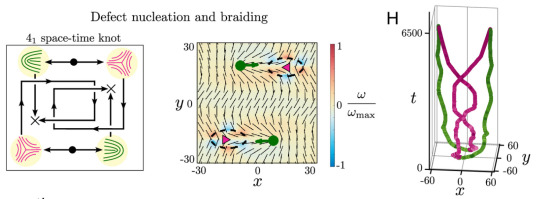
(and it's open access! :D)
I am sooo excited to finally be able to share this! I'll probably write some more in the future about what it was like to work on this project, but for now here's what I want to say about it:
I think this work is a beautiful example of how the long, meandering paths of curiosity-driven research can bring us in completely unexpected directions, yielding new ideas and technologies that might never have been found by problem- or profit-driven research.
We started this project because we were interested in the fundamental physics of active topological defects; we wanted to understand and develop a theory to explain their effective properties, interactions, and collective behaviors when they're hosted by a material whose activity is not constant throughout space and time.
Along the way, we accidentally stumbled into a completely new technique for controlling the flow of active 2D nematic fluids, by using symmetry principles to design activity patterns that can induce self-propulsion or rotation of defect cores. This ended up being such a big deal that we made it the focus of the paper, for a few reasons:
Topological defects represent a natural way to have discrete information in a continuous medium, so if we wanted to make a soft material capable of doing logical operations like a computer, controlling active defects might be a really good way of putting that together.
There have also been a number of biological systems that have been shown to have the symmetries of active nematics, with experiments showing that topological defects might play important roles in biological processes, like morphogenesis or cell extrusion in epithelia. If we could control these defects, we'd have unprecedented control over the biological processes themselves.
Right now the technique has only been demonstrated in simulations, but there are a number of experimental groups who are working on the kinds of materials that we might be able to try this in, so hopefully I'll get to see experimental verification someday soon!
#physics#soft matter#materials science#science#academia#mathematics#topology#biology#biotechnology#tech#publishing#196
74 notes
·
View notes
Text
This day in history
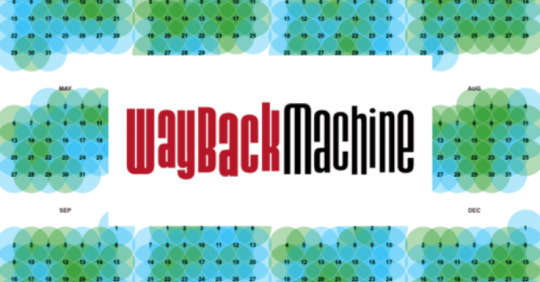
I'm in TARTU, ESTONIA! AI, copyright and creative workers' labor rights (TOMORROW, May 10, 8AM: Science Fiction Research Association talk, Institute of Foreign Languages and Cultures building, Lossi 3, lobby). A talk for hackers on seizing the means of computation (TOMORROW, May 10, 3PM, University of Tartu Delta Centre, Narva 18, room 1037).

#20yrsago Japan jails academic for writing P2P app https://web.archive.org/web/20040512194433/http://straitstimes.asia1.com.sg/latest/story/0,4390,250207,00.html
#20yrsago Blogger redesign notes https://stopdesign.com/journal/2004/05/09/blogger.html
#20yrsago TheyRule: applying information design to corporate directorships https://theyrule.net
#20yrsago Don’t just protect the unconceived: protect the inanimate! https://fafblog.blogspot.com/2004_05_02_fafblog_archive.html#108411098508640046
#15yrsago Brit MP saw undercover cops egging crowd to riot at G20 https://www.theguardian.com/politics/2009/may/10/g20-policing-agent-provacateurs
#15yrsago Elsevier has an entire division dedicated to publishing fake advertorial “peer-reviewed” journals https://science.slashdot.org/story/09/05/09/1514235/more-fake-journals-from-elsevier
#10yrsago Against the instrumental argument for surveillance https://www.theguardian.com/technology/blog/2014/may/09/cybersecurity-begins-with-integrity-not-surveillance
#10yrsago Congressmen ask ad companies to pretend SOPA is law, violate antitrust https://www.eff.org/deeplinks/2014/05/pols-ad-networks-pretend-we-passed-sopa-and-never-mind-about-antitrust
#10yrsago Japanese man arrested for 3D printing and firing guns https://kotaku.com/japanese-man-arrested-for-having-guns-made-with-a-3d-pr-1573358490
#5yrsago Americans with diabetes are forming caravans to buy Canadian insulin at 90% off https://www.cbc.ca/news/canada/nova-scotia/americans-diabetes-cross-canada-border-insulin-1.5125988
#5yrsago Big Tech is deleting evidence needed to prosecute war crimes, and governments want them to do more of it https://www.theatlantic.com/ideas/archive/2019/05/facebook-algorithms-are-making-it-harder/588931/
#5yrsago Buried in Uber’s IPO, an aggressive plan to destroy all public transit https://48hills.org/2019/05/ubers-plans-include-attacking-public-transit/
#1yrago KPMG audits the nursing homes it advises on how to beat audits https://pluralistic.net/2023/05/09/dingo-babysitter/#maybe-the-dingos-ate-your-nan
7 notes
·
View notes
Text




By: Aaron Sibarium
Published: Jan 30, 2024
It's not just Claudine Gay. Harvard University's chief diversity and inclusion officer, Sherri Ann Charleston, appears to have plagiarized extensively in her academic work, lifting large portions of text without quotation marks and even taking credit for a study done by another scholar—her own husband—according to a complaint filed with the university on Monday and a Washington Free Beacon analysis.
The complaint makes 40 allegations of plagiarism that span the entirety of Charleston's thin publication record. In her 2009 dissertation, submitted to the University of Michigan, Charleston quotes or paraphrases nearly a dozen scholars without proper attribution, the complaint alleges. And in her sole peer-reviewed journal article—coauthored with her husband, LaVar Charleston, in 2014—the couple recycle much of a 2012 study published by LaVar Charleston, the deputy vice chancellor for diversity and inclusion at the University of Wisconsin-Madison, framing the old material as new research.
Through that sleight of hand, Sherri Ann Charleston effectively took credit for her husband's work. The 2014 paper, which was also coauthored with Jerlando Jackson, now the dean of Michigan State University's College of Education, and appeared in the Journal of Negro Education, has the same methods, findings, and description of survey subjects as the 2012 study, which involved interviews with black computer science students and was first published by the Journal of Diversity in Higher Education.

The two papers even report identical interview responses from those students. The overlap suggests that the authors did not conduct new interviews for the 2014 study but instead relied on LaVar Charleston's interviews from 2012—a severe breach of research ethics, according to experts who reviewed the allegations.
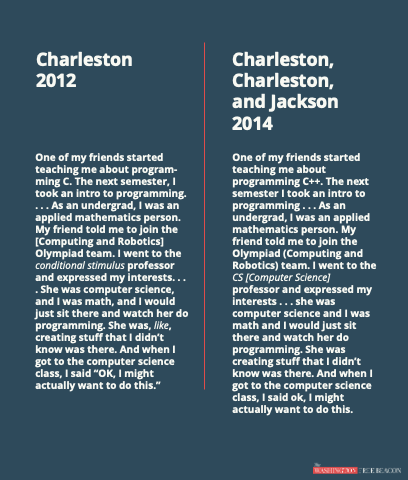
"The 2014 paper appears to be entirely counterfeit," said Peter Wood, the head of the National Association of Scholars and a former associate provost at Boston University, where he ran several academic integrity probes. "This is research fraud pure and simple."
Sherri Ann Charleston was the chief affirmative action officer at the University of Wisconsin-Madison before she joined Harvard in August 2020 as its first-ever chief diversity officer. In that capacity, Charleston served on the staff advisory committee that helped guide the university's presidential search process that resulted in the selection of former Harvard president Claudine Gay in December 2022, according to the Harvard Crimson.
A historian and attorney by training, Charleston has taught courses on gender studies at the University of Wisconsin, according to her Harvard bio, which describes her as "one of the nation's leading experts in diversity." The site says that her work involves "translating diversity and inclusion research into practice for students, staff, researchers, postdoctoral fellows and faculty of color."
Experts who reviewed the allegations against Charleston said that they ranged from minor plagiarism to possible data fraud and warrant an investigation. Some also argued that Charleston had committed a more serious scholarly sin than Gay, Harvard's former president, who resigned in January after she was accused of lifting long passages from other authors without proper attribution.
Papers that omit a few citations or quotation marks rarely receive more than a correction, experts said. But when scholars recycle large chunks of a previous study—especially its data or conclusions—without attribution, the duplicate paper is often retracted and can even violate copyright law.
That offense, known as duplicate publication, is typically a form of self-plagiarism in which authors republish old work in a bid to pad their résumés. Here, though, the duplicate paper added two new authors, Sherri Ann Charleston and Jerlando Jackson, who had no involvement in the original, letting them claim credit for the research and making them party to the con.
"Sherri Charleston appears to have used somebody else's research without proper attribution," said Steve McGuire, a former political theory professor at Villanova University, who reviewed both the 2012 and 2014 papers.
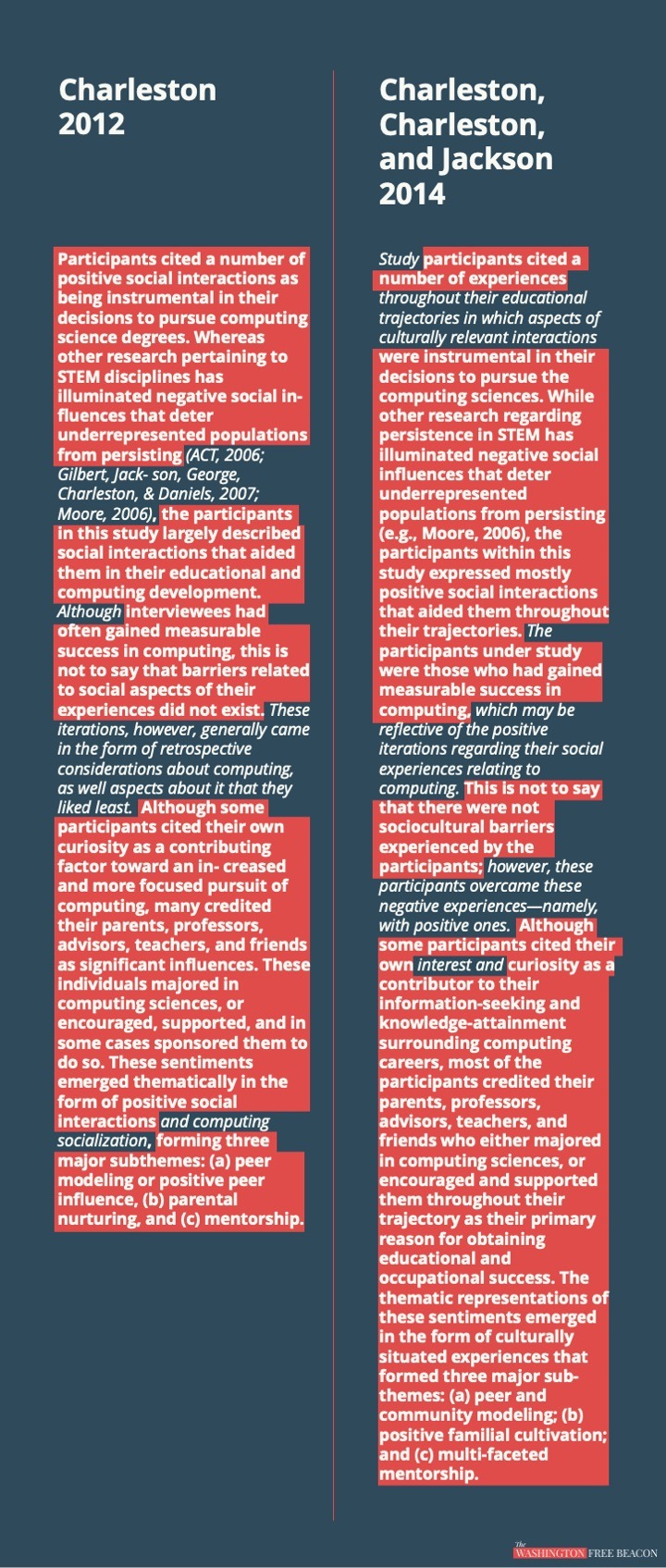
One-fifth of the 2014 paper, including two-thirds of its "findings" section, was published in the 2012 study, according to the complaint, and three interview responses are identical in both articles, suggesting they come from the same survey.
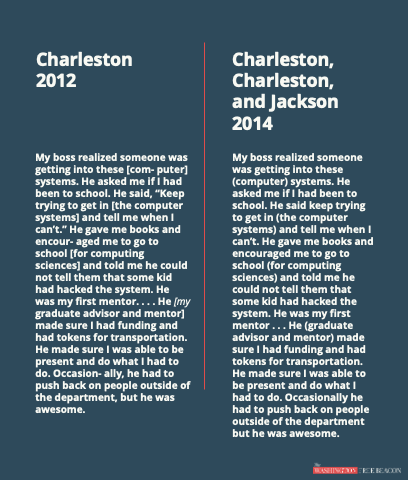
According to Lee Jussim, a social psychologist at Rutgers University, "it is essentially impossible for two different people in two different studies to produce the same quote." At best, he said, the authors got their wires crossed and mixed up interviews from two separate surveys, both of which just happened to involve 37 participants with the exact same demographic profile. At worst, the authors committed data fraud by framing old survey responses as new ones—a separate and more serious offense.
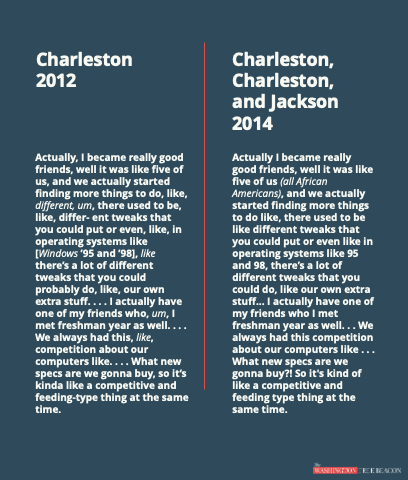
The Journal of Negro Education did not respond to a request for comment. Sherri Ann Charleston, LaVar Charleston, and Jerlando Jackson did not respond to requests for comment.

Monday's complaint, which was filed anonymously, comes as Harvard is facing questions about the integrity of its research affiliates and the ideology of its diversity bureaucrats, most of whom report to the sprawling office that Sherri Ann Charleston oversees.
The Dana-Farber Cancer Institute, one of Harvard Medical School's three teaching hospitals, announced in January that it would retract six papers and correct dozens more after some of its top executives were accused of data manipulation. That news came on the heels of a viral essay in which Carole Hooven, a Harvard biologist, described how she had been hounded out of a teaching role by her department's diversity committee after she said in an interview that there are only two sexes.
The school is also facing an ongoing congressional probe over its handling of anti-Semitism and its response to the plagiarism allegations against Gay, which Harvard initially sought to suppress with legal saber-rattling. Half of Gay's published work contained plagiarized material, ranging from single sentences to entire paragraphs, with some of the most severe lifts coming in her dissertation. Though Gay stepped down as president on January 2, she remains a tenured faculty member drawing a $900,000 annual salary.
Some of Charleston's offenses are similar to Gay's. In her 2009 dissertation, for example, Charleston borrows a sentence from Eric Arnesen's 1991 book Waterfront Workers of New Orleans: Race, Class, and Politics, 1863-1923, without quotation marks and without citing Arnesen's work in a footnote.
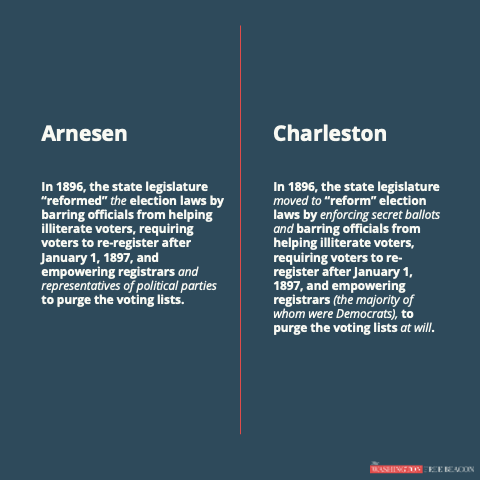
She also lifts full paragraphs from her thesis adviser, Rebecca Scott, while making minimal semantic tweaks.
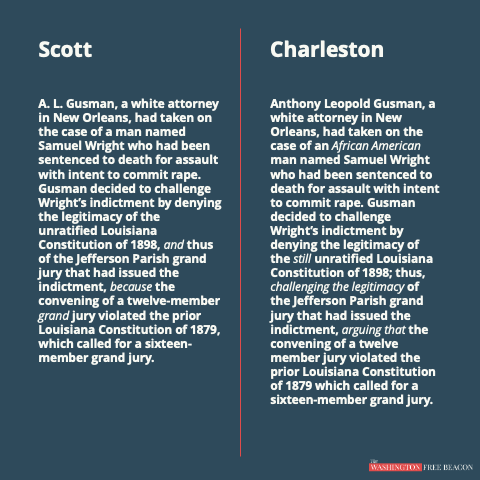
"There's simply not enough difference to consider them original words," said Jonathan Bailey, the founder of the website Plagiarism Today. "Though the sources in those examples are cited"—Charleston includes a footnote to Scott at the end of each passage—"the text either needed to be quoted or properly paraphrased."

Bailey added that the plagiarism of Scott alone merited an investigation���ideally, he said, "by a neutral party with no ties to either the school or the school's critics."
Harvard did not respond to a request for comment. Scott and Arnesen did not respond to requests for comment.
Charleston also lifted language from Louis Pérez, an historian at the University of North Carolina-Chapel Hill; Alejandro de la Fuente, an historian at Harvard; and Ada Ferrer, an historian at New York University, among other scholars.

Charleston cites each source in a footnote but omits quotation marks around language copied verbatim. The omissions violate Harvard's Guide to Using Sources, a document produced for incoming students, which states that quotation marks are required when "you copy language word for word."
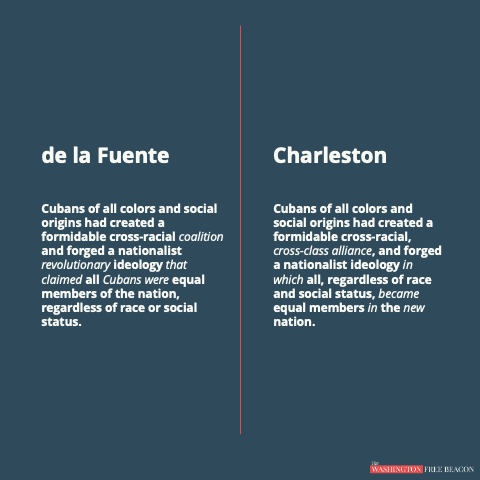
Pérez, de la Fuente, and Ferrer did not respond to requests for comment.

The range of examples presented in the complaint, which was also filed to the University of Michigan and the University of Wisconsin-Madison, highlights how plagiarism can shade into more severe forms of misconduct when it involves interviews or other data.
In fact, some experts said the term "plagiarism" didn't quite capture the dishonesty of duplicate publication, which is sometimes categorized as a separate offense and accounts for 14 percent of all paper retractions in the life sciences.
"You cannot just republish an old paper as if it is a new paper," Jussim, the Rutgers psychologist, said. "If you do, that is not exactly plagiarism; it's more like fraud."
Wood said the case was really a combination of the two offenses. "Because the second paper, on which Sherri Ann Charleston is one of the three co-authors, recycles so much of the text of the original paper by LaVar J. Charleston, this does have the earmarks of plagiarism, but the plagiarism is compounded by an even larger effort to deceive," he said. "The universities and journals need to investigate."
While scholars can reuse data across multiple papers, they must make clear when they are doing so and provide appropriate attribution to earlier studies, per guidelines from the Office of Research Integrity and the editorial policies of top academic journals, including Nature and Cell.
But the 2014 paper never indicates that it is reusing research from 2012. Instead, it claims to present new data that fill a "gap" in the literature and "corroborate" the 2012 study, among others, and on two occasions refers to survey subjects as "participants in this study."
Those participants appear to be the same people whom LaVar Charleston interviewed in 2012. Both surveys involved the same number of undergraduates, graduate students, Ph.D.s, and students at historically black colleges—all drawn from the same computer science conference—a similarity that experts said was a red flag.
"It is curious that the proportions are identical," said Debora Weber-Wulff, a German computer scientist who researches plagiarism and other forms of academic misconduct. "This would be grounds for the universities in question to request the data and investigate."
Jussim agreed. "This seems sufficiently improbable that, absent something saying they are re-reporting an already-published study, it would be fraud," he said.
LaVar Charleston did not respond to a request for comment about whether the two studies used the same interviews. The University of Michigan said it was "committed to fostering and upholding the highest ethical standards in research and scholarship," but declined to comment on the complaint. The University of Wisconsin-Madison told the Free Beacon it had "initiated an assessment in response to the allegations."
The main difference between the papers is a long section in the 2014 article about "culturally responsive pedagogy theory," which the authors say their findings support. Both articles are littered with the tropes of progressive scholarship, including a disclaimer about "positionality"—the authors assure readers that they reflected on their own "racial, gender, and socioeconomic status"—and a lament that computer science is a "White male-dominated field."
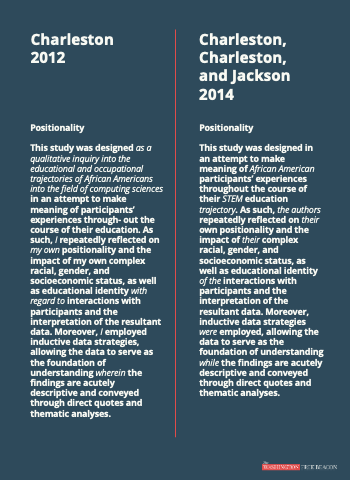
Both also criticize the idea that "computing sciences is for nerds, only for White people, [and] only for geniuses."
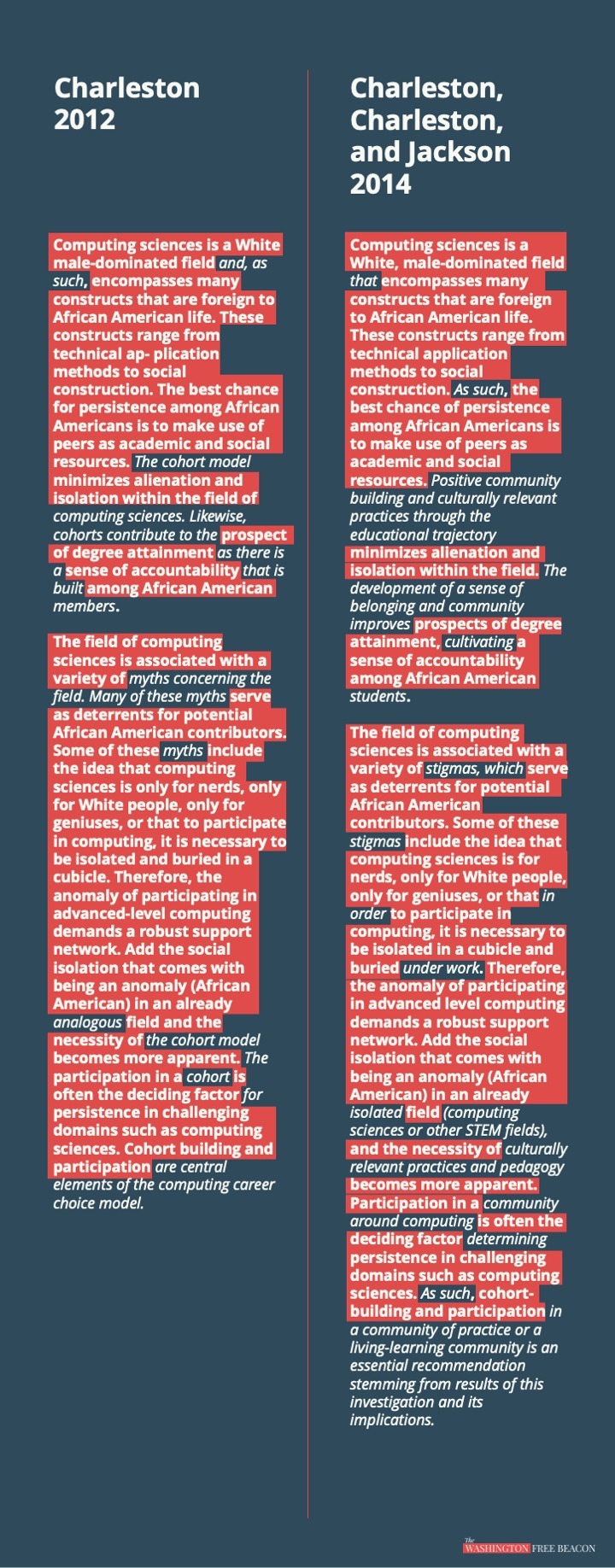
Such language is typical of the diversity initiatives Charleston oversees. Since 2020, her office has pumped out a stream of materials that bemoan the "weaponization of whiteness," discuss the ins and outs of "white fragility," and urge students to "call out" their peers for "harmful words." One message, signed by Charleston herself, was titled "A Call to Dismantle Intersecting Oppressions."
"We must continue to work against systematic oppression in all its forms—racism, sexism, homophobia, ableism, and more," she wrote.
Her office also curates resources for students seeking to become fluent in progressive patois, including a "glossary of diversity, inclusion and belonging (DIB) terms" that provides examples of "gaslighting."
Tactics can include "shooting down the target's ideas," the entry reads—or "taking credit for them."
==
Here we go again...
If you haven't already figured it out, the DEI-related faux-"disciplines" - the "Studies": Ethnic Studies, Women's Studies, Gender Studies, Postcolonial Studies, Media Studies, etc - are the most corrupt, the most ideological with the absolute lowest academic standards of all. All they care about is echoing back the "correct" opinions, not valid scholarship.
And yet, somehow these lunatics and fanatics end up the most powerful people in the asylum.
Harvard needs to fumigate the house, top to bottom.
#Aaron Sibarium#Sherri Ann Charleston#Claudine Gay#Harvard#Harvard University#academic corruption#DEI#DEI bureaucracy#diversity officer#chief diversity officer#diversity equity and inclusion#diversity#equity#inclusion#plagiarism#academic fraud
8 notes
·
View notes
Text
The Causal Potency of Consciousness
The other day I read The causal potency of consciousness in the physical world on the arXiv, by Danko Georgiev.
I know little about this author, other than that he has several other preprints on the arXiv on this and related subjects. His affiliation is listed as the Institute for Advanced Study in Varna, but on the Web site of that organization, he appears as the only author, so that appears to be a shell for him. Some of the papers listed there do have other authors in addition to Georgiev.
Georgiev also is the author of the textbook Quantum Information and Consciousness, published by CRC Press and available from Routledge.
And Georgiev is the chief editor of the online, open access journal Quanta (not to be confused with the online magazine Quanta!). Some of the authors published in the open access journal Quanta appear in other peer-reviewed journals of academic science (e.g. Stan Gudder).
Whatever. Georgiev is not a professor, nor is he an institutional researcher, and he appears to be near the fringe.
But he is not on the fringe, or beyond it.
Georgiev's paper presents ideas that I myself had a year or so ago, when I was regularly answering questions on Quora and used that as an excuse to do some amateur philosophizing. And these thoughts of mine go way back to my twenties, when I was trying to relate Chaitin's ideas about Kolmogorov complexity to self-consciousness.
The paper is written in a clear and accessible style and makes several arguments:
Consciousness must provide a selective advantage to conscious animals, including human beings. I had also made this argument, but I am not 100% sure the argument does not beg the question. After all, it might be objected that something physical both causes consciousness and provides a selective advantage.
Consciousness, as a quantum process, observes itself and this is a quantum measurement. I had also made this argument, but again, I am not 100% sure that the argument does not beg the question.
Consciousness has no causal potency from the standpoint of classical physics. I agree.
The quantum state of an organism is capable of indeterminate behavior, which in conscious organisms can be identified with free will, which is required for any satisfying theory of moral responsibility. I also had made this argument, and I went a bit further and pointed out that a free choice must appear random from the standpoint of classical physics, yet is rationally motivated from the standpoint of consciousness. In my view, this overcomes the objection that random behavior cannot be free.
I also have made the argument that human self-consciousness involves a fixed point that is not possible in classical physics, and may not be possible even in quantum physics.
And I have argued that quantum indeterminacy means the phenomenal world is not computable.
I am still not happy with the clarity and completeness of my arguments, and I am still working on them. But I do not doubt that they are all wound up with the points above.
Yet it is very nice to see that these ideas are circulating and may receive the attention and further research I think they deserve.
3 notes
·
View notes
Text
Toxicity Case Reports Journal
Toxicity Case Reports Journal publishes case reports in Toxicity journal, images in Toxicity Case Reports Journal , journal of Toxicity case reports, case reports in Toxicology journal, journal of Toxicology case reports etc. Toxicity literally means poisonous or noxious and logos refers to the underlying science that explains the adverse effects of toxicity at the organismal level.
Toxicology is therefore a multidisciplinary field which is at the interface of Biology, Chemistry and Medicine, with a special focus on Pharmacology. The subject discusses the presence of physical, biological and chemical agents in the Biological system and the way they affect its functions. Toxicology places special emphasis on the dosage of toxic substances, the route of exposure, species, age, sex, and the environment.
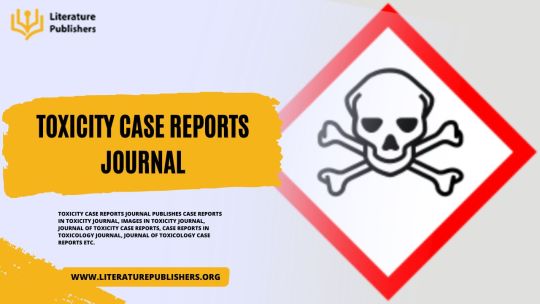
Toxicology: Case Reports Journal
Journal of Toxicology Case Reports is an Open Access journal published. The Journal publishes original research articles, review articles, and clinical studies in all areas of toxicology. Open access publishing proposes a relatively new model for scholarly journal publishing that provides immediate, worldwide, barrier-free access to the full-text of all published articles.
Open access allows all interested readers to view, download, print, and redistribute any article without a subscription, enabling far greater distribution of an author's work than the traditional subscription-based publishing model. The journal uses an editorial tracking system that helps in providing good quality in the review process.
Toxicity Case Reports Journal Highlights: Aflatoxins, Cardiac Toxicity, Chemical Toxicology, Developmental Toxicology, Drug Toxicity, Heavy Metal Toxicity, Heavy Metal Toxins, Industrial Hygiene Toxicology, Insecticides Toxicology, Metal Toxicology, Nano Toxicology, Pesticidal Toxicology, Renal Toxicity, Reproductive Toxicology, Skin Toxicology, Tetanus Toxin, Toxicogenomics, Toxicology Reports, Toxicology Testing.
Journal of Forensic Toxicology & Pharmacology
Journal of Forensic Toxicology & Pharmacology: Journal of Forensic Toxicology and Pharmacology is a peer-reviewed scholarly journal and aims to publish articles in all areas of forensic toxicology, forensic science and pharmacology. The field of forensic science has come a long way and this is particularly true in the area of forensic toxicology, which is both fascinating and important for many applications.
Forensic toxicology is a discipline of forensic science which aids in medical or legal death investigation including disciplines such as analytical chemistry, pharmacology and clinical chemistry. Journal highlights include: Analytical Chemistry, Anthropometry, Clinical Chemistry, Clinical Pharmacology, Computer Forensics, Digital Forensics, Drug Chemistry, Drugs of abuse, Environmental Forensics Fingerprints, Forensic Criminology, Forensic Death Investigation, Forensic Dentistry, Forensic Engineering, Forensic Genetics, Forensic Medicine, Forensic Neuropsychology, Forensic Pathology, Forensic Pharmacology, Forensic Psychiatry, Forensic Science, Forensic Toxicology, Medical and Clinical Toxicology
Related Journals: Forensic Toxicology, Indian Journal of Forensic Medicine & Toxicology, Forensic Science International, Forensic Science International: Genetics, Journal of Forensic Sciences, Forensic Science, Medicine, and Pathology, Journal of Analytical Toxicology, Clinical Toxicology, Environmental Toxicology and Pharmacology, Journal of Pharmacology and Toxicological Studies
International Journal of Chemical Sciences: International Journal of Chemical Sciences is a peer reviewed Quarterly Research Journal encompassing all the branches of Chemical Sciences like Inorganic, Organic, Physical, Analytical, Biological, Pharmaceutical, Industrial, Environmental, Agro and Soil Chemistry as well as Chemical Physics and Engineering etc
American Journal of Drug Delivery and Therapeutics
American Journal of Drug Delivery and Therapeutics: American Journal of Drug Delivery and Therapeutics is an open access peer reviewed and bi-monthly published research journal that publishes articles in the field of Drug Delivery and Therapeutics. It is an international journal to encourage research publication to research scholars, academicians, professionals and students engaged in their respective fields.
Our mission is to advance research by working to develop and maintain competence, ethics and integrity and the highest professional standards in the specialty for the benefit of the public. The faculty seeks, through its activities, to bring about an improvement in research of the public.
American Journal of Drug Delivery and Therapeutics is an international, peer-reviewed, open access online journal publishing original research, reviews focusing on all aspects of drug delivery systems.
Specific topics in the journal include: The properties and design of drugs, Excipients and drug penetration enhancers, Vaccines, Nanotechnology in therapeutics, Polymers for drug delivery, Drug delivery systems including oral, nasal, pulmonary, parenteral, topical and transdermal Controlled release systems; nanoparticles, microparticles, microcapsules, liposomes. Pharmacokinetics, pharmacodynamics, Biopharmaceutics, Medical devices.
Der Chemica Sinica
Der Chemica Sinica: The primary mission of the Der chemica Sinica is to become the premier source of high quality research from the whole of the world. All authors not only receive fast and comprehensive peer-review but also the article promotion to researchers working in the same field. Der chemica Sinica is peer-reviewed and is published in electronic version.
The language of the Der chemica Sinica is English.Der chemica Sinica is an Open Access that aims to publish a complete and reliable source of information on discoveries and current developments as original articles, review articles, case reports, short communications, etc. in all areas of the chemistry science and making them available online without any subscriptions to the researchers worldwide. The editors welcome articles in this multidisciplinary field of chemistry.
Chemical Informatics
Chemical Informatics: Chemical Informatics is a vast field that aims to disseminate information regarding the design, structures, creation, dissemination, analysis, visualisation and the use of chemical information.
Chemical Informatics Journal aims to supply scientists of resources in order to provide the scientific knowledge through the publication of peer-reviewed, high quality, scientific papers and other material on all topics related to Chemical information, Software and databases, Molecular modelling, Computer- aided drug design, Molecular graphics, Data mining techniques, QSAR, Use of chemical structures and their representation in chemical substance and chemical reaction databases. Journal Highlights: Models of Chemistry, Chemical Databases and Maintenance, Chemical Information, QSAR, Data Mining Techniques, Database Software
Related Journals: Journal of Cheminformatics, Journal of Molecular Modeling, Journal of Molecular Structure, Journal of Molecular Graphics and Modelling, Drug Discovery Today.
Journal of Medical Toxicology and Clinical Forensic Medicine
Journal of Medical Toxicology and Clinical Forensic Medicine: Journal of Medical Toxicology and Clinical Forensic Medicine is a Scholarly Open Access scientific journal which deals with both toxicology and Forensic medicine. Medical Toxicology is nothing but a medical subspecialty concentrating on the analysis, supervision and prevention of harming and additional adversative health issues due to medicines, work-related and ecological contaminants, and organic causes.
Clinical Forensic Medicine (CFM) is a health field which deals with the collaboration of clinical medicine and the law. It is also involved in the examination of healthcare doctors who are believed to be impaired or may be a possible risk to the public for other reasons. Journal Highlights includes: Forensic Analysis, Forensic Pathology, Toxicology, Forensic Technologies, Forensic Science, Clinical Forensic Analysis, DNA FingerPrinting, Crime investigation, Toxicity Analysis, Jurisdiction
Related Journals: Forensic Nursing, Autopsy, Nanotoxicology, Forensic Science, Journal of Forensic Sciences, Forensic Science International, International Journal of Legal Medicine, Journal of Forensic and Legal Medicine, Legal Medicine, Toxicology, Environmental Toxicology and Chemistry, Critical Reviews in Toxicology, Regulatory Toxicology and Pharmacology; Environmental Toxicology, Clinical Toxicology, Journal of Applied Toxicology, The American Journal of Forensic Medicine and Pathology, Journal of Indian Academy of Forensic Medicine, Indian Journal of Forensic Medicine & Toxicology, Journal of Clinical Forensic Medicine.
Journal of Heavy Metal Toxicity and Diseases
Journal of Heavy Metal Toxicity and Diseases: Heavy Metal Toxicity refers to an overexposure to lead, mercury, arsenic, cadmium, chromium or other high density or metallic element that causes irritation or damage to the body.
Heavy metals can be found naturally in the environment, in homes, or at the workplace. Sudden severe exposures as well as moderate exposures over time can cause toxicity. Depending on the exposure, metals can increase cancer risk, impair production of red and white blood cells, causes Nausea, Vomiting, Rice-water diarrhoea, Encephalopathy, MODS, LoQTS, Painful neuropathy, Blue vomitus, GI irritation/ Haemorrhage, Hemolysis, MODS (ingested); MFF (inhaled), Vomiting, GI Haemorrhage, Cardiac depression, Metabolic acidosis, Very high doses: Haemorrhage, Bone marrow Suppression, Pulmonary Edema, Hepatorenal necrosis.The main aim of this journal is to provide the quality of data on Heavy Metal Toxicity and related diseases due to severe exposure to Heavy Metals.
Related Journals: The New England Journal of Medicine, Blood Transfusion, Medicine and Healthcare Journal, Iron Chelation Therapy Journal, Blood Journal, Scientific World Journal, Global Journal of Medical Research, Occupational Medicine & Health Affairs Journal, Journal of Experimental Botany, Iranian Journal of Toxicology, Journal of Heavy Metals Toxicity and the Environment, International Journal of Toxicology Heavy Metal Poisoning and Cardiovascular Disease, Heavy metal poisoning from Ayurvedic medicines.
Authors are requested to submit their manuscript by using Online Manuscript Submission Portal:https://www.literaturepublishers.org/submit.html
For more information on Literature Publishers - Toxicity Case Reports Journal visit our site:- https://www.literaturepublishers.org/event/Toxicity-Case-Reports-Journal.html
#case reports in Toxicity journal#images in Toxicity journal#journal of Toxicity case reports#case reports in Toxicology journal#journal of Toxicology case reports
2 notes
·
View notes
Text
01/07/24, 3:43 PM EST: At this time of day, I saw "the dress" as a white and gold dress that appeared to be in the "shade," (which to me gave the "white" part of the dress a "light bluish" tinge).
UPDATE 01/07/24, 4:50 PM EST: I had originally reblogged this post in the late afternoon. It is interesting that when I revisited this post later to add to it, it was in the early evening, so my blinds were closed and no more sunlight was coming in my window behind me to shine on my computer screen. Consequently, at first glance, the dress looked darker, with it almost being a very light blue (especially the photo on the Wikipedia link above), and a dark gold or mustard color. 🤔
For more information on what the colors of "the dress" actually are and why some people see the dress as "blue and black" and others as "white and gold," (and a few as "blue and brown" or "other), see below the cut.
Yes, the actual dress is blue and black, which I can clearly see in the photos below.


Both photos above are from BuzzFeed. Above left is a photo of the dress worn to a wedding by the mother of the bride (who started the whole thing when she took the original photo and showed it to the bride and groom before the wedding). Above right is a photo of the dress from the company it came from: Roman Originals.
Roman Originals (now just Roman) also has an image on its #THE DRESS That Broke the Internet website that fades from the blue & black to the white & gold dress, represented below by this (edited) gif:

Fun facts from the Roman's #THE DRESS website:
"The dress" is a viral meme that launched to stardom on 26th February 2015, when the world disagreed over whether the item of clothing below was black and blue or white and gold. The phenomenon revealed differences in human colour perception which have been the subject of ongoing scientific investigation in neuroscience and vision science, with a number of papers published in peer-reviewed science journals. In popular discourse, the disagreement over the colours was sometimes referred to as "dressgate". But to us it will always be our Dress that broke the internet. After 7.6 Million tweets it's time to seperate the fact from fiction
* 3,622,960 visitors to our website in 48 hours * 2,214,343 uses of #thedress * covered on over 150 networks including BBC Worldwide, Sky, CNN, Fox, ABC, CBS, Globo TV, NTN24, Nippon TV and more... * 70% of people asked actually saw white and gold instead of blue and black * 73 million views of #thedress across all social media channels * 34 minutes was the amount of time it took for our website to sell out of #thedress We even made a #WhiteandGold version that was auctioned off for Charity
It appears that some of the illusion might have been caused by "the dress" having been photographed with yellow-tinged lighting. According to Wikipedia:
Daniel Hardiman-McCartney of the College of Optometrists stated that the picture was ambiguous, suggesting that the illusion was caused by a strong yellow light shining onto the dress, and human perception of the colours of the dress and light source by comparing them with other colours and objects in the picture.[40] [...] The first large-scale scientific study on the dress was published in Current Biology three months after the image went viral. The study, which involved 1,400 respondents, found that 57 per cent saw the dress as blue and black, 30 per cent saw it as white and gold, 11 per cent saw it as blue and brown, and two per cent reported it as "other".[44] Women and older people disproportionately saw the dress as white and gold. The researchers further found that, if the dress was shown in artificial yellow-coloured lighting, almost all respondents saw the dress as black and blue, while they saw it as white and gold if the simulated lighting had a blue bias.[33][44][45][46] Another study in the Journal of Vision, by Pascal Wallisch, found that people who were early risers were more likely to think the dress was lit by natural light, perceiving it as white and gold, and that "night owls" saw the dress as blue and black.[47][48] A study carried out by Schlaffke et al. reported that individuals who saw the dress as white and gold showed increased activity in the frontal and parietal regions of the brain. These areas are thought to be critical in higher cognition activities such as top-down modulation in visual perception.[49][50] [emphasis added]
The yellow-tinged light hypothesis might account for why the dress seemed to change colors for me slightly from the time I first saw it with sunlight hitting my computer screen through the window behind me, to when I revisited it in the evening, when my blinds were closed.
I'm also an older woman, so I fit in the demographics of those most likely to see the dress as white and gold. However, I'm not a particularly "early riser" (although I do have to get up early for work🤷🏻♀️).
Optical illusions are always fascinating.
[edited]
In February 2015, the "The Dress" debate had everyone weighing in on what color it was.

11K notes
·
View notes
Text
How To Write And Publish A Technical Research Paper In iJRASET

Publishing a technical research paper is a cornerstone of academic and professional growth, serving as a platform to share innovations and insights. iJRASET (International Journal for Research in Applied Science and Engineering Technology) is among the leading paper publishing journals, offering a respected venue for researchers to publish groundbreaking work. Its rigorous standards and diverse readership make it an ideal choice for those aiming to excel in research paper publication and effectively disseminate their findings.
Understanding iJRASET’s Scope and Requirements
Before crafting your technical research paper, familiarize yourself with iJRASET’s scope. The journal covers a broad array of disciplines, including applied sciences, engineering technologies, and computational advancements. As one of the most reputable journals to publish research papers, iJRASET emphasizes adherence to submission guidelines such as word count, formatting, and originality. Non-compliance can lead to rejection or delays, underscoring the need for meticulous preparation.
Selecting a Relevant Technical Topic
The choice of topic can significantly influence the impact of your technical research paper. Prioritize originality and relevance by identifying unresolved problems or emerging trends in your field. For instance, topics like AI-driven solutions for sustainable engineering or advancements in nanotechnology align well with iJRASET's focus areas. Innovative thinking paired with practical applications enhances your chances of successful technical paper publishing in journals like iJRASET.
Conducting In-Depth Research
High-quality research forms the backbone of any technical research paper. Utilize reputable databases, scholarly journals, and experimental data to build a robust foundation. Systematically analyze existing literature to uncover gaps and formulate unique hypotheses. Employ advanced tools like simulation software or statistical programs to enhance the depth of your study, ensuring it meets the standards expected by paper publishing journals.
Drafting a Clear Research Framework

A well-defined framework organizes your technical research paper effectively. Start by articulating clear objectives and hypotheses, which serve as the guiding principles for your study. Develop a detailed methodology that outlines experimental setups, computational models, or theoretical approaches. This clarity not only aids your writing but also ensures your paper adheres to the expectations of research paper publication in prestigious journals.
Writing a Technically Sound Manuscript
Technical research demands precision and clarity. Craft an engaging introduction that contextualizes your study and explains its significance. Use concise language to describe methods and results, ensuring every detail contributes to the paper’s objectives. Support findings with tables, graphs, and charts for visual clarity. Avoid excessive jargon; instead, focus on making complex concepts accessible, which is crucial for successful technical paper publishing in journals.
Ensuring Proper Formatting and Referencing
Formatting plays a critical role in maintaining professional standards. iJRASET mandates specific styles for headings, citations, and layouts, similar to other reputable journals to publish research papers. Follow these meticulously to ensure your paper meets journal requirements. Proper referencing not only credits original sources but also bolsters the credibility of your technical research paper, enhancing its value in the realm of research paper publication.
Reviewing and Refining the Manuscript
Even the most brilliant technical research paper benefits from thorough review. Proofread for grammatical errors, technical accuracy, and logical flow. Pay attention to formatting consistency and adherence to submission guidelines. Consider seeking feedback from peers or mentors to gain fresh perspectives. This iterative process enhances the overall quality of your manuscript, positioning it favorably for technical paper publishing in journals like iJRASET.
Submitting Your Paper to iJRASET

The submission process is straightforward yet requires careful attention to detail. Visit the iJRASET website and access the submission portal. Prepare supplementary documents, such as author declarations or plagiarism reports, as per the guidelines. Double-check the uploaded files to avoid errors, ensuring all elements are correctly formatted and complete. This meticulousness is essential for ensuring a smooth research paper publication experience.
Handling Feedback and Revisions
Feedback from iJRASET reviewers is invaluable for refining your technical research paper. Approach critiques constructively, addressing comments with clear explanations or additional research if necessary. Revisions should be implemented methodically, ensuring each aspect of the feedback is thoroughly addressed. Professionalism in your responses fosters positive reviewer interactions, a key to successful technical paper publishing in journals.
Post-Publication Insights
Publication marks the beginning of a new chapter. Share your technical research paper across professional networks, academic forums, and social media platforms to maximize visibility. iJRASET's wide reach amplifies the impact of your research, opening doors to collaborations and professional opportunities. Leveraging publication in prestigious paper publishing journals like iJRASET not only enhances your academic profile but also inspires future research endeavors.
Conclusion
Publishing a technical research paper in iJRASET is a rewarding experience, reflecting a commitment to excellence in technical research. By following these steps, researchers can navigate the process effectively, contributing meaningful insights to their field and advancing their professional aspirations. This guide underscores the importance of meticulous preparation, aligning with the highest standards of research paper publication.
#publish research paper online#research paper publication#journals to publish research papers#research paper publishing sites#research paper published
0 notes
Text
TOC: Institute of Computer Science, Polish Academy of Sciences: Vol. 12 / No. 2 (2024)
It is our pleasure to announce the publication of issue 12(2) – a special issue on computational approaches to morphological typology – of the Journal of Language Modelling (JLM), a free Diamond Open-Access peer-reviewed journal aiming to bridge the gap between theoretical, formal and computational linguistics: http://jlm.ipipan.waw.pl/ (see “CURRENT” or “ALL ISSUES”). The direct persistent link to this issue is: http://jlm.ipipan.waw.pl/index.php/JLM/issue/view/32. JLM is indexed by SCOPUS, E http://dlvr.it/TGvHg1
0 notes
Text
MIT welcomes Frida Polli as its next visiting innovation scholar
New Post has been published on https://sunalei.org/news/mit-welcomes-frida-polli-as-its-next-visiting-innovation-scholar/
MIT welcomes Frida Polli as its next visiting innovation scholar

Frida Polli, a neuroscientist, entrepreneur, investor, and inventor known for her leading-edge contributions at the crossroads of behavioral science and artificial intelligence, is MIT’s new visiting innovation scholar for the 2024-25 academic year. She is the first visiting innovation scholar to be housed within the MIT Schwarzman College of Computing.
Polli began her career in academic neuroscience with a focus on multimodal brain imaging related to health and disease. She was a fellow at the Psychiatric Neuroimaging Group at Mass General Brigham and Harvard Medical School. She then joined the Department of Brain and Cognitive Sciences at MIT as a postdoc, where she worked with John Gabrieli, the Grover Hermann Professor of Health Sciences and Technology and a professor of brain and cognitive sciences.
Her research has won many awards, including a Young Investigator Award from the Brain and Behavior Research Foundation. She authored over 30 peer-reviewed articles, with notable publications in the Proceedings of the National Academy of Sciences, the Journal of Neuroscience, and Brain. She transitioned from academia to entrepreneurship by completing her MBA at the Harvard Business School (HBS) as a Robert Kaplan Life Science Fellow. During this time, she also won the Life Sciences Track and the Audience Choice Award in the 2010 MIT $100K Entrepreneurship competition as a member of Aukera Therapeutics.
After HBS, Polli launched pymetrics, which harnessed advancements in cognitive science and machine learning to develop analytics-driven decision-making and performance enhancement software for the human capital sector. She holds multiple patents for the technology developed at pymetrics, which she co-founded in 2012 and led as CEO until her successful exit in 2022. Pymetrics was a World Economic Forum’s Technology Pioneer and Global Innovator, an Inc. 5000’s Fastest-Growing company, and Forbes Artificial Intelligence 50 company. Polli and pymetrics also played a pivotal role in passing the first-in-the-nation algorithmic bias law — New York’s Automated Employment Decision Tool law — which went into effect in July 2023.
Making her return to MIT as a visiting innovation scholar, Polli is collaborating closely with Sendhil Mullainathan, the Peter de Florez Professor in the departments of Electrical Engineering and Computer Science and Economics, and a principal investigator in the Laboratory for Information and Decision Systems. With Mullainathan, she is working to bring together a broad array of faculty, students, and postdocs across MIT to address concrete problems where humans and algorithms intersect, to develop a new subdomain of computer science specific to behavioral science, and to train the next generation of scientists to be bilingual in these two fields.
“Sometimes you get lucky, and sometimes you get unreasonably lucky. Frida has thrived in each of the facets we’re looking to have impact in — academia, civil society, and the marketplace. She combines a startup mentality with an abiding interest in positive social impact, while capable of ensuring the kind of intellectual rigor MIT demands. It’s an exceptionally rare combination, one we are unreasonably lucky to have,” says Mullainathan.
“People are increasingly interacting with algorithms, often with poor results, because most algorithms are not built with human interplay in mind,” says Polli. “We will focus on designing algorithms that will work synergistically with people. Only such algorithms can help us address large societal challenges in education, health care, poverty, et cetera.”
Polli was recognized as one of Inc.’s Top 100 Female Founders in 2019, followed by being named to Entrepreneur’s Top 100 Powerful Women in 2020, and to the 2024 list of 100 Brilliant Women in AI Ethics. Her work has been highlighted by major outlets including The New York Times, The Wall Street Journal, The Financial Times, The Economist, Fortune, Harvard Business Review, Fast Company, Bloomberg, and Inc.
Beyond her role at pymetrics, she founded Alethia AI in 2023, an organization focused on promoting transparency in technology, and in 2024, she launched Rosalind Ventures, dedicated to investing in women founders in science and health care. She is also an advisor at the Buck Institute’s Center for Healthy Aging in Women.
“I’m delighted to welcome Dr. Polli back to MIT. As a bilingual expert in both behavioral science and AI, she is a natural fit for the college. Her entrepreneurial background makes her a terrific inaugural visiting innovation scholar,” says Dan Huttenlocher, dean of the MIT Schwarzman College of Computing and the Henry Ellis Warren Professor of Electrical Engineering and Computer Science.
0 notes
Text
MIT welcomes Frida Polli as its next visiting innovation scholar
New Post has been published on https://thedigitalinsider.com/mit-welcomes-frida-polli-as-its-next-visiting-innovation-scholar/
MIT welcomes Frida Polli as its next visiting innovation scholar


Frida Polli, a neuroscientist, entrepreneur, investor, and inventor known for her leading-edge contributions at the crossroads of behavioral science and artificial intelligence, is MIT’s new visiting innovation scholar for the 2024-25 academic year. She is the first visiting innovation scholar to be housed within the MIT Schwarzman College of Computing.
Polli began her career in academic neuroscience with a focus on multimodal brain imaging related to health and disease. She was a fellow at the Psychiatric Neuroimaging Group at Mass General Brigham and Harvard Medical School. She then joined the Department of Brain and Cognitive Sciences at MIT as a postdoc, where she worked with John Gabrieli, the Grover Hermann Professor of Health Sciences and Technology and a professor of brain and cognitive sciences.
Her research has won many awards, including a Young Investigator Award from the Brain and Behavior Research Foundation. She authored over 30 peer-reviewed articles, with notable publications in the Proceedings of the National Academy of Sciences, the Journal of Neuroscience, and Brain. She transitioned from academia to entrepreneurship by completing her MBA at the Harvard Business School (HBS) as a Robert Kaplan Life Science Fellow. During this time, she also won the Life Sciences Track and the Audience Choice Award in the 2010 MIT $100K Entrepreneurship competition as a member of Aukera Therapeutics.
After HBS, Polli launched pymetrics, which harnessed advancements in cognitive science and machine learning to develop analytics-driven decision-making and performance enhancement software for the human capital sector. She holds multiple patents for the technology developed at pymetrics, which she co-founded in 2012 and led as CEO until her successful exit in 2022. Pymetrics was a World Economic Forum’s Technology Pioneer and Global Innovator, an Inc. 5000’s Fastest-Growing company, and Forbes Artificial Intelligence 50 company. Polli and pymetrics also played a pivotal role in passing the first-in-the-nation algorithmic bias law — New York’s Automated Employment Decision Tool law — which went into effect in July 2023.
Making her return to MIT as a visiting innovation scholar, Polli is collaborating closely with Sendhil Mullainathan, the Peter de Florez Professor in the departments of Electrical Engineering and Computer Science and Economics, and a principal investigator in the Laboratory for Information and Decision Systems. With Mullainathan, she is working to bring together a broad array of faculty, students, and postdocs across MIT to address concrete problems where humans and algorithms intersect, to develop a new subdomain of computer science specific to behavioral science, and to train the next generation of scientists to be bilingual in these two fields.
“Sometimes you get lucky, and sometimes you get unreasonably lucky. Frida has thrived in each of the facets we’re looking to have impact in — academia, civil society, and the marketplace. She combines a startup mentality with an abiding interest in positive social impact, while capable of ensuring the kind of intellectual rigor MIT demands. It’s an exceptionally rare combination, one we are unreasonably lucky to have,” says Mullainathan.
“People are increasingly interacting with algorithms, often with poor results, because most algorithms are not built with human interplay in mind,” says Polli. “We will focus on designing algorithms that will work synergistically with people. Only such algorithms can help us address large societal challenges in education, health care, poverty, et cetera.”
Polli was recognized as one of Inc.’s Top 100 Female Founders in 2019, followed by being named to Entrepreneur’s Top 100 Powerful Women in 2020, and to the 2024 list of 100 Brilliant Women in AI Ethics. Her work has been highlighted by major outlets including The New York Times, The Wall Street Journal, The Financial Times, The Economist, Fortune, Harvard Business Review, Fast Company, Bloomberg, and Inc.
Beyond her role at pymetrics, she founded Alethia AI in 2023, an organization focused on promoting transparency in technology, and in 2024, she launched Rosalind Ventures, dedicated to investing in women founders in science and health care. She is also an advisor at the Buck Institute’s Center for Healthy Aging in Women.
“I’m delighted to welcome Dr. Polli back to MIT. As a bilingual expert in both behavioral science and AI, she is a natural fit for the college. Her entrepreneurial background makes her a terrific inaugural visiting innovation scholar,” says Dan Huttenlocher, dean of the MIT Schwarzman College of Computing and the Henry Ellis Warren Professor of Electrical Engineering and Computer Science.
#2022#2023#2024#academia#aging#ai#AI Ethics#Algorithms#Analytics#Articles#artificial#Artificial Intelligence#Awards#honors and fellowships#background#Behavior#Bias#Brain#Brain and cognitive sciences#brain imaging#Business#career#CEO#college#competition#computer#Computer Science#computing#concrete#Disease
0 notes
Text
Dr. Yehia Massoud: Shaping the Future of Engineering Education as Dean at Stevens Institute
Engineering education has always been a cornerstone of technological progress and innovation. At the helm of this transformation is Dr. Yehia Massoud, a distinguished IEEE Fellow, accomplished academic, and visionary leader. As the Dean of the School of Systems and Enterprises (SSE) at Stevens Institute of Technology, Dr. Massoud is redefining the landscape of engineering education to meet the demands of a rapidly evolving world.

A Trailblazing Academic Journey
Dr. Yehia Massoud’s illustrious career spans over two decades, marked by impactful contributions to academia, research, and industry. A graduate of the Massachusetts Institute of Technology (MIT), Dr. Massoud has held prestigious positions at institutions like Rice University, the University of Alabama at Birmingham (UAB), and MIT itself. His deep understanding of both the theoretical and practical aspects of engineering has made him a highly respected figure in the field.
A Visionary Leader at Stevens Institute
Since assuming the role of Dean at the School of Systems and Enterprises, Dr. Massoud has brought transformative changes to the institution. The SSE is renowned for its interdisciplinary programs that integrate engineering, technology, and management principles. Under his leadership, the school has strengthened its reputation as a hub for innovation, fostering a culture that bridges the gap between academic excellence and real-world application.
Key Initiatives Under His Leadership
Curriculum Modernization Dr. Massoud has spearheaded efforts to modernize the curriculum, ensuring that students are equipped with the skills and knowledge needed for emerging fields like artificial intelligence, data science, and systems engineering.
Research Excellence His tenure has seen a significant boost in research initiatives, with a focus on tackling complex global challenges. From sustainable systems to advanced analytics, the SSE’s research output has gained recognition on a global scale.
Industry Partnerships Dr. Massoud has been instrumental in forging strong partnerships with leading organizations. These collaborations provide students with invaluable hands-on experience and ensure that the curriculum remains aligned with industry needs.
Diversity and Inclusion Recognizing the importance of diverse perspectives in driving innovation, Dr. Massoud has championed initiatives to create a more inclusive and equitable environment at Stevens.
Pioneering Research and Contributions Dr. Massoud is not only a leader but also an accomplished researcher. His work has led to breakthroughs in areas like nanoscale computing, energy-efficient systems, and computational methods. His research has been published in over 250 peer-reviewed journals and conference proceedings, solidifying his status as a thought leader in engineering.
His recognition as an IEEE Fellow is a testament to his significant contributions to the advancement of technology. This honor, bestowed on less than 0.1% of IEEE members annually, highlights his dedication to pushing the boundaries of engineering.
Inspiring the Next Generation One of Dr. Massoud’s core missions is to inspire and mentor the next generation of engineers and innovators. He is a firm believer in the power of education to transform lives and societies. Through his efforts, Stevens Institute has become a destination for students who aspire to make a difference in the world.
Keynote Speeches and Thought Leadership Dr. Massoud frequently shares his insights through keynote speeches at conferences and events. His addresses emphasize the importance of interdisciplinary approaches, sustainability, and the ethical dimensions of technology. These thought-provoking talks continue to influence both students and professionals in the engineering community.
A Legacy of Excellence Dr. Yehia Massoud’s leadership at Stevens Institute of Technology is shaping the future of engineering education. His unwavering commitment to academic excellence, innovation, and inclusivity has set a new benchmark for institutions worldwide. As he continues to lead the School of Systems and Enterprises, Dr. Massoud remains dedicated to empowering students and advancing the frontiers of knowledge.
In an era where engineering and technology are critical to addressing global challenges, leaders like Dr. Yehia Massoud play a pivotal role. His vision, expertise, and passion for education are transforming the way we prepare future engineers and problem-solvers. At Stevens Institute, he is not just shaping careers — he is shaping the future.
0 notes
Text
Human Cell Atlas: Mapping the human body for medical breakthroughs

- By Nuadox Crew -
The Human Cell Atlas (HCA) has made significant strides in understanding the human body by mapping all human cells. This international effort has resulted in more than 40 peer-reviewed papers, highlighting large datasets, AI algorithms, and biomedical discoveries.
Key findings include insights into placenta and skeleton formation, brain maturation, new gut and vascular cell states, lung responses to COVID-19, and the genetic basis of diseases.
The HCA uses experimental and computational approaches in single-cell and spatial genomics to create comprehensive reference maps of human cells. Over 3,600 members from 100+ countries have profiled more than 100 million cells from over 10,000 people. The goal is to develop a first draft Human Cell Atlas, eventually encompassing billions of cells across all organs and tissues.
The Nature Portfolio collection demonstrates major advances in three aspects: mapping individual adult tissues or organs, mapping developing human tissues, and developing groundbreaking new analytical methods. These studies provide proof of principle for capturing human diversity, including genetic, geographic, age, and sex variations.
The HCA's comprehensive reference maps of the human body are compared to a 'Google Maps' for cell biology, establishing benchmarks for detecting and understanding changes underlying health and disease. This initiative aims to facilitate precise diagnostics, innovative drug discovery, and advanced regenerative medicine approaches.
Read more at Human Cell Atlas
Scientific journals: The Human Cell Atlas: towards a first draft atlas. (2024, November 20). Nature. https://www.nature.com/immersive/d42859-024-00060-5/index.html
Related Content
Bone marrow atlas offers new insights into blood cell development
Other Recent News
SpaceX Discounts Starlink Mini to $165: SpaceX has discounted its Starlink Mini to $165, although it's not available in the US yet.
Apple Releases Fix for Zero-Day Attack: Apple has released a fix for a zero-day attack targeting Macs and iPhones.
OpenAI Brings ChatGPT’s Advanced Voice Mode to Browsers: OpenAI has introduced an advanced voice mode for ChatGPT, available to paid users.
DOJ Wants to Force Google to Sell Chrome: The US Department of Justice is proposing that Google be forced to sell Chrome and license search data to rivals.
Vionic Launches Innovation Lab: Vionic has launched the Vionic Innovation Lab (VioLab) to advance the science of footwear, focusing on foot health and overall wellness.
Cabinet Approves Continuation of Atal Innovation Mission: The Indian government has approved the continuation of the Atal Innovation Mission (AIM) with a budget of ₹2,750 crore to foster innovation and entrepreneurship.
US Announces $2.2 Billion Boost for Clean Hydrogen Hubs: The US has announced a $2.2 billion boost for clean hydrogen hubs to support sustainable energy.
Mars’ Moons Phobos and Deimos Could Be Asteroid Debris: A new study suggests that Mars' moons, Phobos and Deimos, could be made of asteroid debris.
Solar Orbiter Sends High-Resolution Images of Sun’s Surface: The Solar Orbiter has sent back high-resolution images of the Sun’s surface, revealing new details.
0 notes
Text
Understanding the ABDC Journal List: A Comprehensive Guide

ABDC Journal List is widely regarded as a critical resource for evaluating the quality of journals in the disciplines of business, management, economics, and related fields. Developed and maintained by the Australian Business Deans Council (ABDC), this curated list serves as a benchmark for scholars, researchers, and institutions worldwide. Whether you're a PhD student, an early-career researcher, or an established academic, understanding the ABDC Journal List is essential for effectively navigating the landscape of academic publishing.
What is the ABDC Journal List?
The ABDC Journal List is a ranking system that categorizes academic journals in business and related disciplines into four quality tiers: A, A, B, and C*. These rankings are based on criteria such as:
Impact factor
Citations and academic influence
Reputation among scholars
Editorial and review quality
The Four Tiers Explained
A*
The highest category, signifying journals with substantial international recognition and influence.
Often includes top-tier journals like Journal of Marketing, Academy of Management Journal, and Journal of Finance.
A
High-quality journals with strong reputations in their respective fields.
Examples might include Strategic Management Journal or Journal of Business Research.
B
Solid, reputable journals with a consistent record of scholarly contributions.
Ideal for researchers targeting respectable outlets that balance accessibility and visibility.
C
Journals that meet the minimum standards of academic publishing but may have limited reach or influence.
Useful for niche topics or emerging areas of research.
Importance of the ABDC Journal List
1. Quality Assurance for Researchers
For academics, publishing in a journal listed on the ABDC Journal List can significantly enhance credibility. The rankings ensure that researchers choose outlets that meet stringent quality standards, minimizing the risk of predatory or low-quality publications.
2. Benchmarking for Academic Institutions
Universities often use the ABDC Journal List to evaluate the performance of faculty members. Publications in higher-tier journals (A* or A) are typically rewarded more in tenure, promotion, or grant applications.
3. Guidance for Doctoral Candidates
PhD students can use the list to identify suitable journals for their dissertations or early publications. Publishing in A* or A journals can enhance their academic profiles early in their careers.
4. Industry Relevance
For practitioners and policymakers, the ABDC List helps identify journals that provide rigorous and credible insights, bridging the gap between academia and real-world applications.
Methodology Behind the ABDC Journal List
The ABDC revises its journal list periodically to ensure relevance and accuracy. Here’s an overview of the evaluation process:
Nominations and Submissions
Scholars, institutions, and journal editors can nominate journals for inclusion or reconsideration during the review cycle.
Assessment by Panels
Subject-area panels, comprising experts in various disciplines, evaluate the journals based on established metrics like citations, editorial standards, and peer-review quality.
Consultation and Feedback
The ABDC consults widely with the academic community to gather feedback before finalizing the rankings.
Finalization
The updated list is published, reflecting the latest changes in journal quality and relevance.
Key Trends and Debates Surrounding the ABDC List
1. Rising Importance of Interdisciplinary Research
As research grows increasingly interdisciplinary, many scholars advocate for the inclusion of journals from adjacent fields like psychology, sociology, and computer science. This broadening of scope reflects the evolving nature of business research.
2. Criticism of Ranking Systems
While the ABDC List provides valuable guidance, it has faced criticism for its perceived bias towards established journals in Western contexts. Critics argue that this focus can disadvantage emerging journals from developing regions.
3. Pressure to Publish in A Journals*
The "publish or perish" culture in academia often emphasizes publishing in A* journals, which can lead to undue pressure on researchers. Balancing quality with accessibility remains a significant challenge.
4. Impact of Open Access Journals
With the rise of open-access publishing, researchers are increasingly questioning the relevance of traditional metrics like impact factor. Some argue for a greater emphasis on journals' accessibility and societal impact.
How to Leverage the ABDC Journal List
Identifying Target Journals
Use the ABDC Journal List to identify journals that align with your research interests and quality aspirations.
Consider not just the ranking but also the journal’s specific focus, audience, and submission criteria.
Strategic Publishing
Early-career researchers might aim for B or A journals initially to build their profiles, while established academics can target A* outlets for greater impact.
Understanding Institutional Expectations
Familiarize yourself with your institution's policies regarding the ABDC List, as some may have specific requirements for promotion or funding.
Staying Updated
Since the ABDC List is periodically updated, keep an eye on the latest editions to ensure your target journals remain relevant.
Conclusion
The ABDC Journal List is more than a ranking system; it is a cornerstone of academic publishing in business and related disciplines. By providing a standardized framework for evaluating journal quality, it empowers researchers to make informed decisions and ensures the integrity of scholarly contributions. However, like any ranking system, it is not without limitations. Researchers must use it as a guide rather than an absolute determinant, balancing quality with accessibility and relevance.
As academia continues to evolve, the ABDC Journal List will undoubtedly adapt to new challenges and opportunities, maintaining its critical role in shaping the future of business research. Whether you're aiming for the prestigious A* tier or exploring emerging C-level journals, a strategic approach to the ABDC List can enhance your academic journey.
#ABDC journals in India#ABDC Journal List pdf#ABDC Journal list excel#ABDC Journal List 2024 excel#ABDC Journal search#ABDC Journal List 2024 pdf download#ABDC journal fast publication#ABDC List 2024
0 notes
Text
https://www.sciencedirect.com/browse/journals-and-books
0 notes
Text
Gamified Video Games Show Promise in Supporting Mental Health for Children and Teens, Johns Hopkins Study Reveals

In a comprehensive review of past studies, researchers from Johns Hopkins Children’s Center have found that video games specifically designed as mental health interventions may serve as modest but beneficial tools for improving the well-being of children and teenagers struggling with anxiety, depression, and attention-deficit/hyperactivity disorder (ADHD).
The findings were published on September 23, 2024, in JAMA Pediatrics, following an analysis of studies from peer-reviewed journals between 2011 and March 20, 2024. The report highlights the potential of these “gamified digital mental health interventions” to offer some relief to a growing population of young individuals facing mental health challenges.
According to the Agency for Healthcare Research and Quality, an estimated 20% of U.S. children and teenagers aged 3 to 17 have a mental, emotional, developmental, or behavioral disorder. This statistic is concerning, especially when considering that suicidal behaviors among high school students increased by over 40% in the decade before 2019. The disruptions caused by the COVID-19 pandemic have only exacerbated these issues, leading to longer wait times for mental health appointments, despite increased efforts by parents and caregivers to seek care.
Dr. Barry Bryant, a resident in the Department of Psychiatry and Behavioral Sciences at Johns Hopkins University School of Medicine and the study’s lead author, expressed concern over the insufficient number of pediatric mental health providers to meet the growing demand. “Even doubling the number of pediatric mental health providers still wouldn’t meet the need,” he stated.
In their study, Dr. Bryant, along with child and adolescent psychologist Dr. Joseph McGuire, reviewed 27 randomized clinical trials involving 2,911 participants aged 6 to 17 years old from the U.S. and other countries. The trials focused on the use of digital mental health interventions—specifically video games designed to treat ADHD, depression, and anxiety.
These video games were diverse in content, targeting specific conditions with different approaches. For instance, games for ADHD involved activities that required players to split their attention between multiple tasks, while those for depression and anxiety incorporated therapeutic concepts into the gameplay. The interventions were delivered through various platforms, including computers, tablets, video game consoles, and smartphones.
The Johns Hopkins research team standardized effect sizes using a random-effects model to evaluate the effectiveness of these interventions. Their analysis revealed that video games designed to address ADHD and depression provided modest improvements in symptoms such as sustained attention and reduced sadness, with an effect size of 0.28. However, games targeting anxiety showed little to no benefit, with an effect size of 0.07.
Further analysis identified factors that positively influenced the effectiveness of these digital interventions. For example, games delivered on computers or with preset time limits, as well as those involving more boys, were associated with better outcomes. These insights suggest potential avenues for enhancing the current modest benefits observed in digital mental health interventions.
“While the benefits are still modest, our research shows that we have some novel tools to help improve children’s mental health—particularly for ADHD and depression—that can be relatively accessible to families,” said Dr. McGuire, an associate professor of psychiatry and behavioral sciences. He noted that gamified mental health interventions could serve as an initial step for children awaiting more traditional therapy.
The study authors also cautioned that their review did not pinpoint why certain video game interventions were more effective than others. Additionally, they noted that the studies varied in their use of outcome measures, some relying on parent- or child-reported outcomes rather than standardized clinician assessments. The researchers also acknowledged that many of the games studied are not readily accessible, often being behind paywalls or available only through specific research teams.
Despite concerns about video game addiction and excessive screen time, the study found that children who engaged with these interventions in a structured, time-limited manner tended to benefit the most. “If a child has a video game problem, they are often playing it for several hours a day as opposed to a gamified digital mental health intervention that might be 20-45 minutes, three times a week,” Dr. Bryant explained.
Dr. McGuire emphasized the importance of having a variety of tools to address the increasing demand for child mental health care. The study was funded by generous donors and Johns Hopkins Medicine, with no conflicts of interest declared by the Johns Hopkins-affiliated authors.
Conclusion
As mental health challenges among children and teenagers continue to rise, innovative solutions like gamified video games offer a promising, albeit modest, approach to providing support. With further research and development, these digital interventions could become a valuable component of comprehensive mental health care for young people.
#health#medicine#pain management#mental health#apdss#chiropractic#neckpain#back pain#neurostar#depressionhelp
0 notes